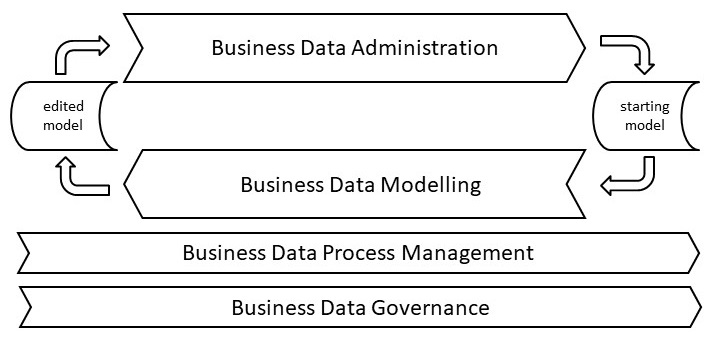Business Data Governance
Introduction
Business Data Management consists of three main interacting processes:
- Business Data Administration
- Business Data Modelling
and the additional, supportive business function:
- Business Data Process Management
Business Data Administration is responsible for collecting, classifying, storing, controlling all Business Data Models (i.e.: meta data) and informing and advising all stakeholders on this matter. Starting models are delivered to the Modelling function.

Business Data Modelling concerns all projects and activities specifying (among others) Business Data Models. It may be activities to document the status quo or activities that have the goal to accomplish transitions of or within the organisation. Edited Business Data Models are a deliverable for the activity which have to be accepted by Business Data Administration.
Business Data Process Management is responsible for designing, implementing and maintaining the processes used by and setting standards and guidelines on Business Data Management, in particular on Business Data Administration and Business Data Modelling and the efficiency and effectiveness of the exchange process between those two functions. On top of that, these processes and systems will supply the Business Data Governance function with information regarding (the execution of) Business Data Management.
Business Data Governance concerns putting the BDM organisation, management and control cycles in place regarding the above mentioned functions and executing it.
Remark:
This section is about Business Data Governance and concerns the top management role of Business Data Management. Be aware that in regular Data Management, with the focus on data (Data values) itself, the process management function often is referred to as “Data Governance”, which is correct from that perspective. Within BDM we consider Business Data Process Management as a separate supportive business function and “Business Data Governance” as the management (governance) of the Business Data Management function.
Business Data Management is from and for the business. The different kinds of ownership we distinguished are all within the business. Be aware that that supportive functions as IT, HR, etc. are considered a business as well with their own Business Data Model. See the page on (Principles of) BDM. So by definition, the business is Accountable for BDM.
Organisation
In terms of BDM organisation, an option is that each business organises and implements its own Business Data Management function. Certain standardisation on BDM throughout the organisation will be advisable, for example by putting functions like Business Data Process Management and/or Business Data Administration on a central level, with a centralised functional responsibility. This way of working will make every business aware of the work to be done and actions to be taken: they have to do it themselves. On the other hand it could lead to business boundary discussions that are not solved and both businesses going their own way. Also in naming and defining business terms that are used by other businesses and do not provide the wider perspective on organisation level.
At the other end of the spectrum, Business Data Management could be organised centrally. In that case it should be expressed that the work must be done decentralised by the businesses, supported by concrete KPI’s about the efforts and results expected. There will be a central view on businesses, their boundaries and how they interact. Results will comply to this central view and in case they do not, they will be rejected.
Often, in organisations where BDM is recognised and implemented, it has evaluated from regular data management and is under responsibility of the Concern Data Officer (CDO) within IT. In that case, BDM could either be integrated within regular data management (because for example there is a need recognised for a business glossary on top of the data models used) ór implemented as a specific pillar/unit under the CDO which may result in a better focus on business instead of data. In both situations you often see that in Business Process Management terms the role of data ánd meta data owners are recognised and implemented in processes, but Accountability of the business on the subject is often ignored because of the integration in regular data management. Because Business Data Management is a tough job and in this situation the business is not accountable for Business Data Governance, it is hard to keep focus and not to fall back on the prime focus of IT: the data itself.
Conclusion is that there is not a single best way to organise BDM. At least it should be tailored to the existing organisation and culture of setting mutual goals and results. In time when an organisation becomes more mature in BDM, reorganisation of (Business) Data Management may be advisable.
Management
Business Data Management will focus on:
- The proper execution of the three BDM processes in both effectivity and efficiency
- Progress in creating the Business Data Model
- Keeping existing Business Data Models in track with business changes
- Keeping the businesses aligned in working together, towards their goals and results on Business Data Management. Communication is vital
- Reporting to and advising the business owner(s).
- Promoting Business Data Management to business and IT.
- Secure involvement of the business(es) in Business Data Management.
- Providing business and IT a well-documented view on the business and keep track of more longer term (strategic, tactical) needs in information management.
There will be a management information need on these topics and BDM processes and systems should be designed to meet these needs, including (changing) workload within the BDM functions.